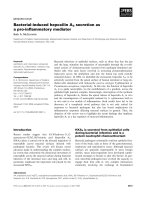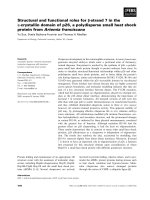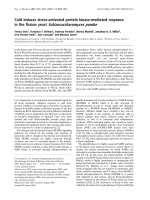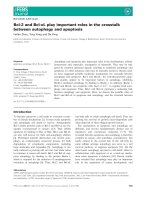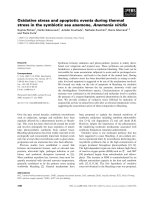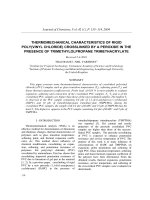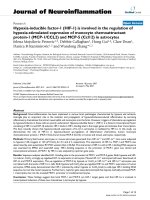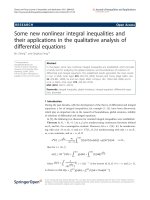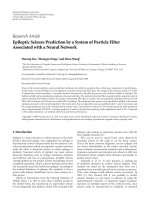Báo cáo "Thermomechanical characteristics of rigid poly(vinyl chloride) crosslinked by a peroxide in the presence of trimethylolpropane trimethacrylate " pdf
Bạn đang xem bản rút gọn của tài liệu. Xem và tải ngay bản đầy đủ của tài liệu tại đây (164.71 KB, 5 trang )
110
Journal of Chemistry, Vol. 42 (1), P. 110 - 114, 2004
thermomechanical characteristics of rigid
poly(vinyl chloride) crosslinked by a peroxide in the
presence of Trimethylolpropane trimethacrylate
Received 5-4-2003
THAI HOANG
1
, NEIL VARSHNEY
2
1
Institute for Tropical Technology, Vietnamese Academy of Science and Technology
2
Institute of Polymer Technology and Material Engineering, Loughborough University,
the United Kingdom
SUMMARY
This paper presents some thermomechanical characteristics of crosslinked poly(vinyl
chloride) (PVC) samples such as glass transition temperature (T
g
), softening point (T
s
), and
linear thermal expansion coefficient (). Probe load of 0.05 N is most suitable to evaluate
expansion, softening and contraction of the crosslinked PVC samples. T
g ,
T
s
and of the
crosslinked PVC samples are higher than those of the uncrosslinked samples. The highest T
g
is observed in the PVC sample containing 0.4 phr of 1,1-di-(t-amylperoxy) cyclohexane
(DAPC) and 10 phr of trimethylolpropane trimethacrylate (TMPTMA). Among the
crosslinked PVC samples, the sample with 0.2 phr of DAPC and 15 phr of TMPTMA has the
least T
s
. The highest appears in the PVC sample containing 0.4 phr of DAPC and 5 phr of
TMPTMA.
I - INTRODUCTION
Thermomechanical analysis (TMA) is an
effective method for determination of dimension
and thickness changes, thermal characteristics of
polymers such as glass transition temperature,
softening point, and thermal expansion coeffi-
cient, etc. This method shows influence of
chemical modification, crosslinking on expan-
sion, softening, and penetration resistance of
polymers. For poly(vinyl chloride) (PVC)
crosslinked by aminosilanes, Fiaz has shown that
crosslinking improved penetration resistance of
PVC due to formation of gel part in the material
[1, 2]. In a previous paper, crosslinking of rigid
PVC by a new peroxide (1,1-di-(t-amylperoxy)
cyclohexane) (DAPC) in the presence of
trimethylolpropane trimethacrylate (TMPTMA)
was reported [3]. Gel content and tensile
properties of the peroxide crosslinked PVC
samples are higher than those of the uncross-
linked PVC samples. The peroxide crosslinking
of PVC is expected to enhance penetration
resistance and service temperature of PVC. The
purpose of this work is to study influence of
concentrations of DAPC and TMPTMA on
expansion, probe penetration and softening of
rigid PVC. Glass transition temperature, softening
point, and linear thermal expansion coefficient of
the polymer have been determined. From the
obtained results, thermal expansion, penetration
resistance, service temperature, and softening of
the cross-linked PVC samples were evaluated (or
determined).
II - EXPERIMENTAL
1. Materials and sample preparation
The PVC used was the K60 PVC suspension
resin EVIPOL SH6030 containing 8.6%
crystallnity, from EVC (the United Kingdom).
The processing aid Paraloid K120N, the
lubricants waxes Loxiol G52 and Loxiol G53, the
wax PE 190 and the heat stabilizer tribasic lead
sulphate (TBLS) were supplied by Rohm Hass
(Germany), eChem (the United Kingdom),
Hoescht (Germany), and Addis (the United
States), respectively. Crosslinking additives were
1,1-di-(t-amylperoxy) cyclohexane (DAPC) from
the Institute of Polymer Technology and Material
Engineering, Loughborough University (the
United Kingdom) and trimethyl-olpropane trime-
thacrylate CH
3
CH
2
C[CH
2
-O-C(O)-C(CH
3
)=CH
2
]
3
(TMPTMA) from Rohm GmbH (Germany).
Proportions of materials used are expressed in
parts per hundred of resin (phr). All samples
contain 1.2 phr of Loxiol G53, 0.4 phr of Loxiol
G52, 0.2 phr of Hoechst PE 190, 1.5 phr of
Paraloid K120N, 7 phr of TBLS. Concentrations
of TMPTMA and peroxide are varied from 5 to
15 phr and 0.2 to 0.6 phr, respectively.
Dry blends are prepared in a laboratory scale
Fielder mixer. All components (except liquid
peroxide and TMPTMA) are placed in the mixer
when temperature of 50
o
C is reached. They are
mixed at 2000 rpm until the temperature is about
80
o
C then TMPTMA and peroxide are added, and
blending continues until 120
o
C is reached. Then
the dry blend is dumped to a cooled chamber.
Dry blends are milled on two-roll mill for 5
minutes at temperature of 140
o
C, then pressed
for 5 minutes at temperature of 185
o
C. Finally,
the PVC sheet is cooled for 5 minutes.
2. Thermomechanical analysis
A thermomechanical analyzer (Mettler
TA4000, Switzerland) with a flat-ended, loaded
probe (dia. 3 mm) is used for thermomechanical
analysis. PVC samples are heated at 10
o
C/min
from room temperature to 210
o
C in air. A
range of loads (0.01 - 0.1 N) on the probe is
investigated. Plots of probe penetration of the
above samples are automatically recorded.
Thermomechanical characteristics such as glass
transition temperature, softening point, and
linear thermal expansion coefficient are
determined by TMA software connected to the
Mettler TA4000. Linear thermal expansion
coefficient is calculated by using the point-to-
point method (a straight line connecting the
chosen temperature limits).
III - RESULTS AND DISCUSSION
Before studying thermomechanical charac-
teristics of the crosslinked PVC samples in
detail, it is necessary to investigate loads on the
probe to select the most suitable load for the
samples. Fig. 1 presents the effect of probe load
(from 0.01 to 0.1 N or from 1.02 to 10.2 g) on
expansion, softening and contraction of a rigid
PVC sample crosslinked by 0.4 phr of DAPC
and 10 phr of TMPTMA. When small loads
(0.01 and 0.03 N) are used, a significant
sample expansion (increase of thickness,
positive l) occurs. However, it is difficult to
estimate contraction of the sample after
softening. With a high probe load (0.1 N), it
sinks into the sample prematurely (decrease of
thickness, negative l), and the expansion of the
sample is not observed. Using middle probe load
(0.05 N), it is able to observe and evaluate both
of expansion and contraction of the crosslinked
PVC sample easily. The same load was also
found to be the optimum in the paper related
with silane crosslinking of PVC [1]. Therefore,
in the following TMA measurements, 0.05 N
probe load is the most suitable for all crosslinked
PVC samples.
Fig. 2 performs TMA curvers of PVC
samples containing the same concentration of
TMPTMA (10 phr) and different concentrations
of DAPC. It is clear that the PVC sample without
peroxide is easier to be softed and penetrated
than the samples crosslinked by the peroxide in
the presence of TMPTMA. It also shows the
crosslinking of poly-TMPTMA onto PVC to
form graft copolymer, crosslinked structures like
PVC-(TMPTMA)
x
and PVC-(TMPTMA)
x
-
PVC as well as three-dimensional network is
able to improve expansion and penetration
resistance of the samples.
11
1
Fig. 2: TMA curvers of PVC samples crosslinked by different concentrations of
DAPC and 10 phr of TMPTMA
Glass transition temperatures (T
g
s) of the
PVC samples containing different concentration
of DAPC and TMPTMA are demonstrated in
Fig. 3. T
g
of all crosslinked PVC samples is
higher than that of the uncrosslinked samples.
This reflects an useful increase in service
temperature of the material. It can be suggested
that the increase in T
g
also relates to the
formation of graft copolymer, with relatively
short bulky chains of poly-TMPTMA linking the
PVC molecules and three-dimensional network.
These structures cause restriction of molecular
mobility and orientation of PVC chains and as a
result, T
g
of the crosslinked PVC samples is
higher than that of the uncrosslinked samples
[4]. At any concentration of TMPTMA, a
maximum T
g
of the PVC samples occurs with
0.4 phr of DAPC. The highest T
g
at this peroxide
concentration is observed in the presence of 10
phr of TMPTMA. T
g
of the PVC crosslinked
samples decreases with increasing concentration
of TMPTMA up to 15 phr. There is possibly
still a plasticization effect operating of
TMPTMA, reducing T
g
of the PVC samples
l,
µ
m
-200
-100
0
100
200
0 phr
0.2 phr
0.4 phr
0.6 phr
0.05 N
0.1 N
Tem perature,
o
C
20 40 60 80 100 120 140 160 180 200 220
l, µm
-300
-200
-100
0
100
200
300
0.01 N
0.03 N
0.05 N
0.1 N
Fig. 1: Effect of probe load on expansion and softening behavious of a rigid PVC sample
crosslinked
11
2
2
despite the homopolymerisation of TMPTMA
like Garcia-Quesada has explained [4].
Therefore, in order to obtain the material with
high service temperature, 0.4 phr of DAPC and
10 phr of TMPTMA can be used in PVC
compound.
Used PVC contains a network of crystallites
(8.6%), which act as physical crosslinks, and
melt over a wide temperature range starting at
about 110
o
C. About T
g
, softening depends on
the melting of these crystallites, but can be
changed by a chemical crosslinked network [5].
The crosslinking influences on the softening
point (T
s
) of the PVC samples in comparing with
the uncrosslinked PVC samples (Table 1). For
the uncrosslinked PVC samples, T
s
decreases
with increasing concentration of TMPTMA. This
can be also explained by the presence of
TMPTMA as a plasticizer. It improves the
molecular mobility, melting and softening of
PVC and a result, T
s
decreases with increasing
concentration of TMPTMA [6, 7]. T
s
of all
crosslinked PVC samples is higher than that of
the uncrosslinked samples. Maximum difference
of T
s
between the uncrosslinked - and
crosslinked PVC samples is 16
o
C. The
crosslinking and grafting of poly-TMPTMA
chain radical on to PVC molecule to form graft
copolymer, crosslinked structures as well as
three-dimensional network limit molecular
mobility and melting of PVC chains. So, the
crosslinked PVC samples are more difficult to be
softed and penetrated. Among the samples
crosslinked by DAPC and TMPTMA, the
sample containing 0.2 phr of DAPC and 15 phr
of TMPTMA has the minimum T
s
.
Table 1: Softening point of the PVC samples containing different concentrations of DAPC and
TMPTMA
Concentrations of Softening point,
o
C
TMPTMA
0 phr of DAPC 0.2 phr of DAPC 0.4 phr of DAPC 0.6 phr of DAPC
0 176 178 181 183
5 175 181 184 186
10 173 184 186 187
15 171 180 185 186
Fig. 3: Glass transition temperature (T
g
) of the PVC samples containing different
concentrations of DAPC and TMPTMA
Peroxide Concentration, phr
0.0 0.1 0.2 0.3 0.4 0.5 0.6 0.7
T
g
,
o
C
55
60
65
70
7
5
80
5 phr TMPTMA
10 phr TMPTMA
15 phr TMPTMA
113
Table 2 presents the influence of concen-
trations of DAPC and TMPTMA on linear
thermal expansion coefficient () of the PVC
samples. The obtained results show that in the
samples without DAPC, only increases with
increasing concentration of TMPTMA up to 10
phr. Thereafter, it decreases with increasing
concentration of TMPTMA. of the crosslin-
ked PVC samples is higher than that of the
uncrosslinked PVC samples. This is explained
by the crosslinking PVC in the presence of DAPC
and TMPTMA as mentioned above. At any
concentration of TMPTMA, a maximum of
the PVC samples also appears at 0.4 phr of
DAPC. The highest at this peroxide
concentration is observed in the presence of 5
phr of TMPTMA. of the PVC crosslinked
samples decreases with increasing concentra-
tion of TMPTMA up to 15 phr. Therefore, in
order to obtain PVC having the highest , 0.4
phr of DAPC and 5 phr of TMPTMA can be
used in the material.
Table 2: Linear thermal expansion coefficient of the PVC samples containing different
concentrations of DAPC and TMPTMA
Concentrations of Linear thermal expansion coefficient, µm/m
o
C
TMPTMA
0 phr of DAPC 0.2 phr of DAPC 0.4 phr of DAPC 0.6 phr of DAPC
0 4.16 6.58 8.34 8.80
5 49.56 226.92 378.02 298.67
10 58.33 238.89 371.77 301.00
15 42.70 198.64 212.69 204.85
IV - CONCLUSION
1. For thermomechanical analysis of crosslin-
ked rigid PVC, probe load of 0.05 N is the most
suitable to observe and evaluate expansion,
softening and contraction of the sample.
2. Glass transition temperature of the PVC
samples crosslinked by DAPC and TMPTMA is
higher than that of the uncrosslinked samples. It
reflects an useful increase in service temperature
of the material. At any concentration of TMP-
TMA, a maximum glass transition temperature of
the PVC samples occurs with 0.4 phr of DAPC.
3. The crosslinked PVC samples are more
difficult to be softed and penetrated than the
uncrosslinked ones. Maximum difference of
softening point between the uncrosslinked - and
crosslinked PVC samples is 16
o
C. Among the
samples crosslinked by DAPC and TMPTMA,
the sample containing 0.2 phr of DAPC and 15 phr
of TMPTMA has the minimum softening point.
4. The PVC sample crosslinked by 0.4 phr
of DAPC and 5 phr of TMPTMA has the
highest linear thermal expansion coefficient.
Acknowledgments: This work is supported by
the Natural Science Council of Vietnam. The
authors would like to thank the Institute of
Polymer Technology and Material Engineering,
Loughborough University (the United Kingdom)
for research facilities.
REFERENCES
1. M. Fiaz, M. Gilbert. Advances in Polymer
Technology, Vol. 17, P. 37 - 51 (1998).
2. I. Kelnar, M. Schatz. J. Appl. Polym. Sci.,
Vol. 48, P. 669 (1993).
3. Thai Hoang, N. Varshney. J. of Chemistry,
Vol. 41, No. 3, P. 127 - 132 (2003).
4. J. C. Garcia-Quesada, M. Gilbert. J. Appl.
Polym. Sci., Vol. 77, P. 2657 - 2666 (2000).
5. T. Hjertberg, R. Dahl. J. Appl. Polym. Sci.,
Vol. 42, P. 107 (1991).
6. H. J. Tai. Polym. Eng. Sci., Vol. 41, P. 998
(2001).
7. H. J. Tai. Polym. Eng. Sci., Vol. 39, P. 1320
(1999).
1
1
4

